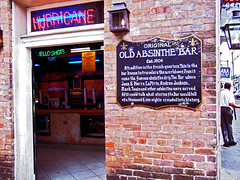Absinthe: Legal again?
To contact us Click HERE SO THE ABSINTHE COMMUNITY is all a-twitter, and, perhaps, with good cause. The anise-flavored spirit has been banned in the United States since 1912, primarily because of overstated concerns about the psychoactive quality of one of its ingredients, thujone, a ketone of wormwood, which is present in true absinthe in small amounts. It didn't help the drink's cause that absinthe was the preferred liquor of Victorian artists and other layabouts, or that there were a few notable cases of people going on murderous rampages after drinking the green spirit. There was, for example, Jean Lanfray, who in 1905 murdered his pregnant wife and two children. Absinthe was blamed, and was banned; never mind the fact that Lanfray, along with a sandwich and two glasses of absinthe, had also drunk five liters of wine, six glasses of cognac, one coffee laced with brandy, and two crème de menthes.
 In the time since the ban, absinthe's reputation has grown, and the drink enjoyed a massive revival in Europe in the Nineties, with European distillers discovering a variety of loopholes in the law that allowed them to put absinthe back on the market. These have not been hard to get in America, although they have not been legal, precisely. There is no law against owning or drinking absinthe in the United States, but it is illegal to manufacture, sell, or import absinthe (a notable exception is Absente, a drink that greatly resembles absinthe, but is made with wormwood's thujone-free relative, southernwood; Absente, however, is not well-liked by hardcore absinthe fans).
In the time since the ban, absinthe's reputation has grown, and the drink enjoyed a massive revival in Europe in the Nineties, with European distillers discovering a variety of loopholes in the law that allowed them to put absinthe back on the market. These have not been hard to get in America, although they have not been legal, precisely. There is no law against owning or drinking absinthe in the United States, but it is illegal to manufacture, sell, or import absinthe (a notable exception is Absente, a drink that greatly resembles absinthe, but is made with wormwood's thujone-free relative, southernwood; Absente, however, is not well-liked by hardcore absinthe fans).Did we say it is illegal to manufacture, or buy, or import absinthe? We meant, it was illegal. Because there is a new absinthe being marketed, made in the United States, called Lucid, and, unlike Absente, it contains thujone. As it turns out, the US laws had a little loophole of their own: Drinks were only illegal of they contained greater than 10mg of thujone per liter. And, as it turns out, most pre-ban absinthe had less than that. Lucid is based on pre-ban recipes -- it was designed by chemist Ted Breaux, a New Orleans-born fellow with a talent for reverse engineering absinthe recipes from old bottles of the stuff.
Fans of European absinthes might take issue with the resulting drink, as, according to a New York Times article, Breaux has reduced the drink's strong anise flavor to suit the American palette. To purists, this is a bit like reducing the flavor of juniper in gin -- anise is one of Absinthe's defining flavors. We shall, however, reserve judgment until we actually sample the stuff, and, in some ways, what Lucid tastes like is rather beside the point. It has been approved for manufacture and sale by the Alcohol and Tobacco Tax and Trade Bureau, and this opens the doors for the manufacture, sale, and, presumably, importing of other absinthes that are likewise made with less than 10mg of thujone per liter. According to what we have read, this is consistent with the European Union's rulings on thujone, and therefore there is a wealth of European absinthes that may now be eligible for legal import to the United States.
It shall be interesting to see how this all plays out. We at the Bottle Gang are fans of absinthe, particularly a refreshing cocktail invented in New Orleans called the absinthe frappe, which was a so popular in the United States back in 1904 that Victor Herbert wrote a hit song named after the drink. But because absinthe's illegality made the liquor prohibitively expensive, we've tended to make our frappes with pastis, such as Herbsaint, which was, after all, originally an absinthe, or at least pretended to be. Our sense is that absinthe's legend is grander than the drink itself, and increased availability should do much to return absinthe to its proper place in the world of cocktails -- that of being a fine, and common, ingredient in a really well-made mixed drinks, such as the Sazerac, rather than being some semi-mystical, hallucinogenic drink of artists and madmen. (SPARBER)

0 Yorum:
Yorum Gönder
Kaydol: Kayıt Yorumları [Atom]
<< Ana Sayfa